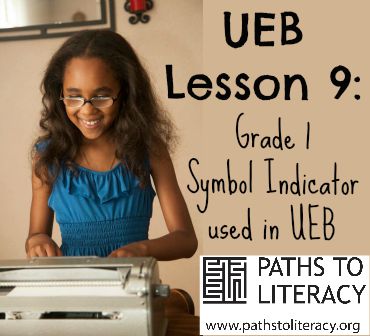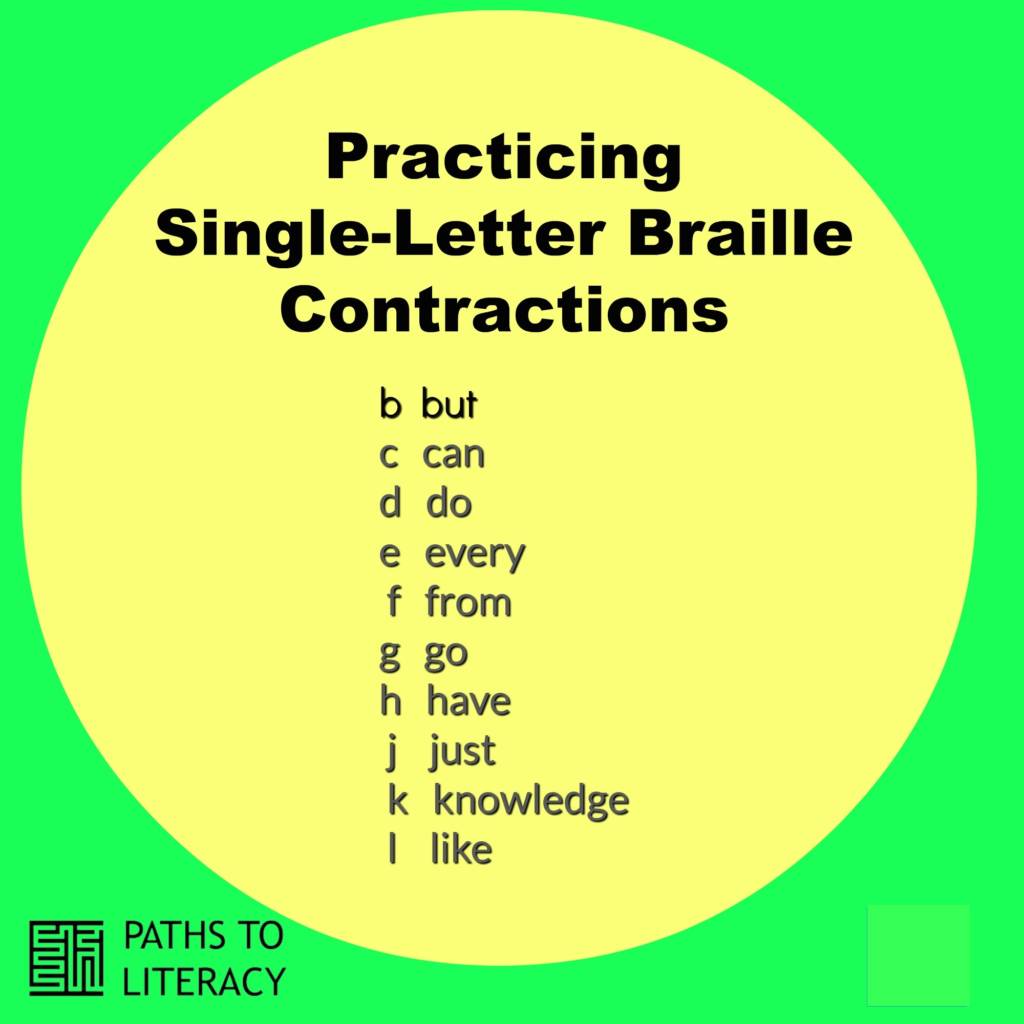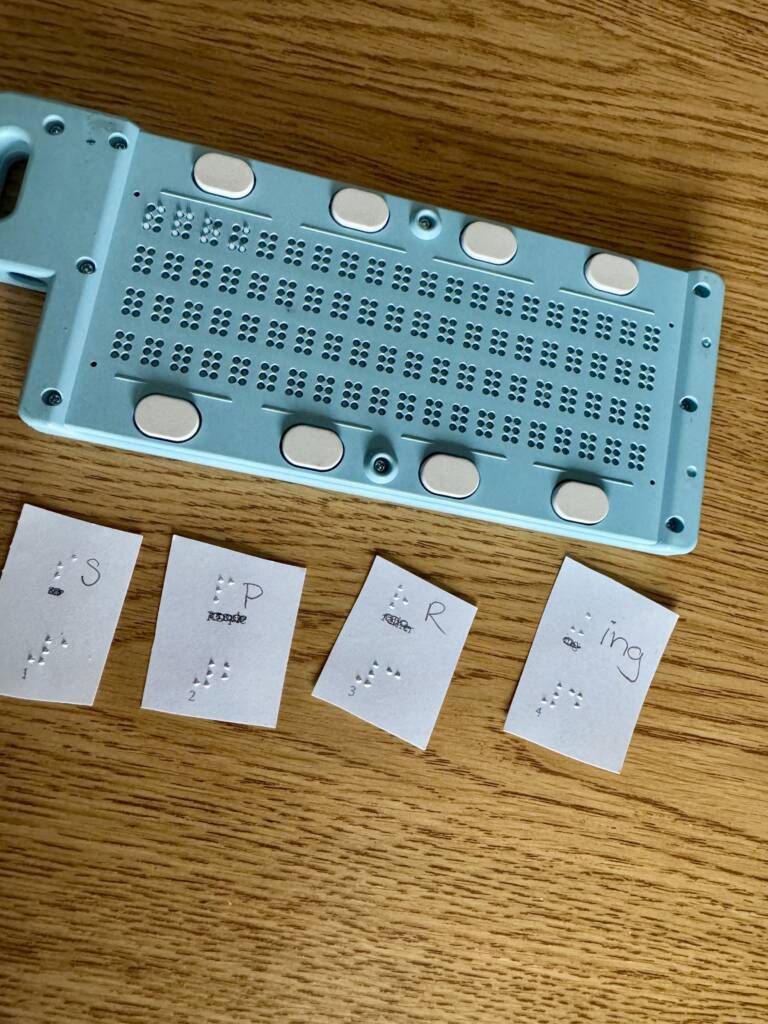This post is the ninth in a series of lessons on teaching students who are braille readers to make the transition from EBAE (English Braille American Edition) to UEB (Unified English Braille). All lessons are by Catherine Summ and Suzanne Cappiello, who both work as Education Consultants for the Department of Rehabilitative Services (DORS-BESB) in CT.
See the full UEB Curriculum with all lessons.
Goal:
The student will be able to identify the grade 1 symbol indicator that is now used in the UEB code.
The grade 1 symbol indicator will always be shown as dots 5,6.
Any character following the grade 1 symbol indicator is not a contraction. Dots 5,6 should be used when a letter stands by itself. Dots 5,6 are not required before a single a, I or o, which do not have contraction forms.
A double dot 5,6 means the next word is in grade 1, and a triple dot 5,6 signals the beginning of a passage that will not include any contractions. The grade 1 passage is terminated with dots 5,6 and 3.
For further explanation of the changes refer to the handout “Overview of Changes from Current Literary Braille to Unified English Braille” authored by Braille Authority of North America, March 2013, www.brailleauthority.org. Refer to the UEB manual for a full explanation of the braille code.

Teacher prepares the examples below in braille. Students practice reading the examples below, and mark the grade 1 indicator.
- She labelled all of the math books with letter m stickers.
- John F. Kennedy was the 35th president of the United States.
- The audience chanted: “Action, action, we want action! A-c-t-i-o-n!”
- Lucy M. Montgomery wrote the “Anne of Green Gables” series of books.
- The correct spelling of our first president’s name is G-e-o-r-g-e W-a-s-h-i-n-g-t-o-n and it will be on the spelling test.
- The word knowledge starts with a k, not an n.
- Vowels are a, e, i, o and u.
- The map has an x where the treasure should be.
Additional Activities: Writing Practice
Dictate the following words, phrases, and sentences to students. Feel free to add your own.
- The word hippopotamus is spelled h-i-p-p-o-p-o-t-a-m-u-s.
- He needed a c in order to spell crabapple in the Scrabble game.
- Making a U turn on Main Street is illegal.
- The h on the map indicates a house.
- Write y for yes and n for no.
- I’m wearing a v neck sweater.
- We are approaching an S curve on the road.
- Everyone in the class earned a B on the exam.
- The baseball team chanted: “r-u-n, r-u-n, r-u-n!” when the batter hit the ball.
Assessment:
Dictate the following words, phrases, and sentences to students. Add your own. Teacher compiles a spreadsheet for each student to document progress and compile data.
- The correct way to spell Jersey in New Jersey is J-e-r-s-e-y.
- Every cake box is marked with a c and every pie box is marked with a p.
- George W. Bush was the 43rd president of the United States.
- The class sang: “B-i-n-g-o, b-i-n-g-o, b-i-n-g-o, and Bingo was his name-O!”
- The s indicates where to write your signature.
- The Bay City Rollers released the song “S-A-T-U-R-D-A-Y Night” in 1974.
- Do not forget the p in raspberry.
- The mayor’s full name is Pat R. Russell.
- All the moving boxes going to the kitchen should have a k on them.
- X marks the spot.
Educational Activity and Game:
Spelling Bee Road Race
Supplies: game tokens, dice, embossed graph paper, poster board, index cards each containing a contracted word
Make a game board using embossed graph paper. Cut the graph paper into strips and glue it to the poster board, or a similar piece of paper. Feel free to make a road pattern of your choice. Using raised stickers, puffy paint, or another tactile marker to randomly mark squares with a symbol for selecting a card. Mark where the road begins and where the road ends.
Students take turns rolling the dice and moving their game piece on the road. If a student lands on a “card” spot they should select a card from the pile. The student reads the word on their card and then brailles the word in its uncontracted format in a sentence using the appropriate grade 1 indicator. If they do this correctly they get to move ahead one square and then wait for their next turn. If they do this incorrectly then they have to move back a square. The person who reaches the finish line first wins.
Download the Duxbury file. (Thank you to Karen Carl for creating and sharing this!)




